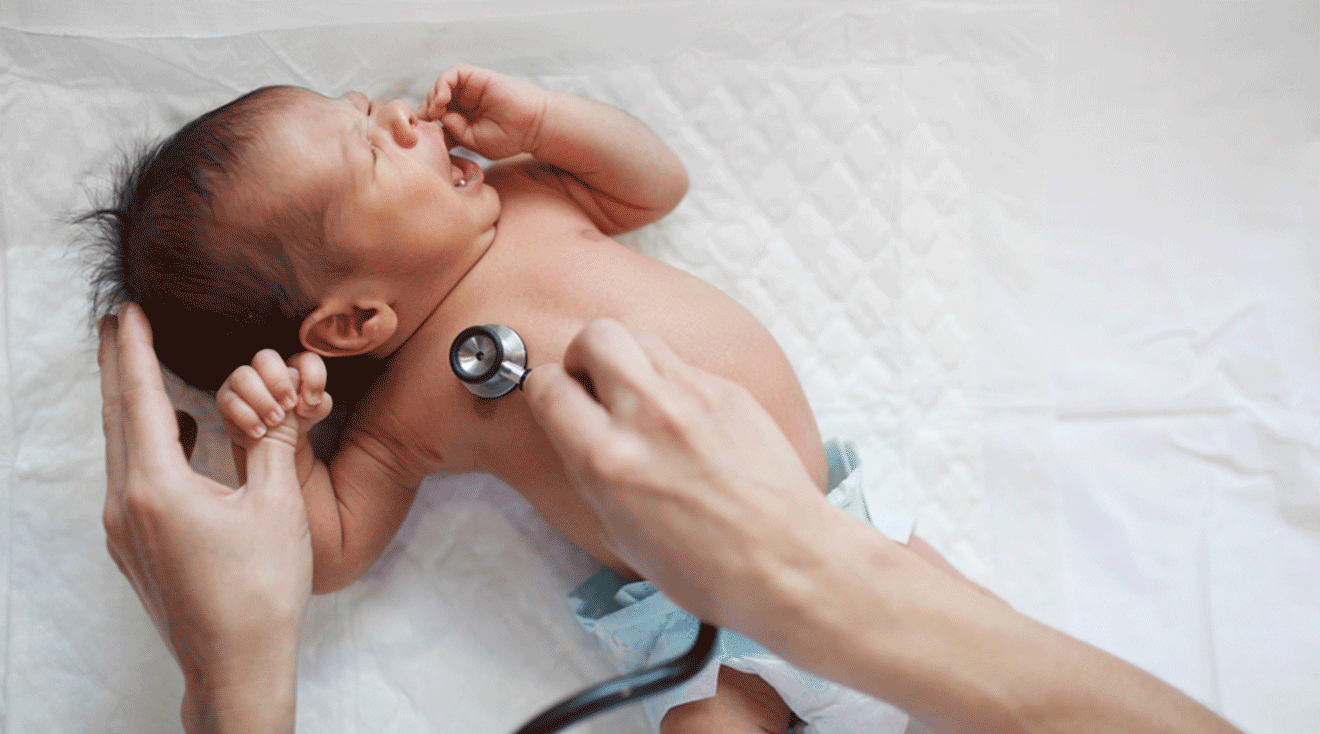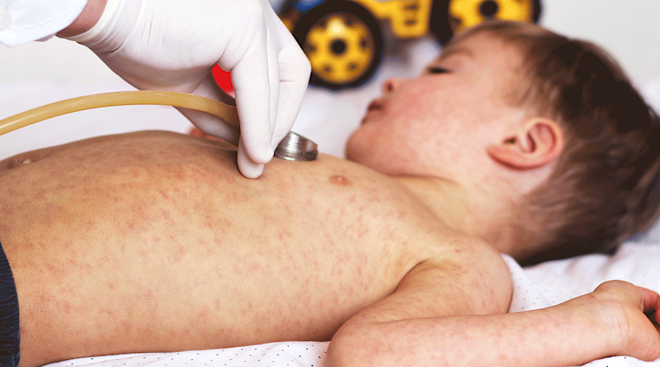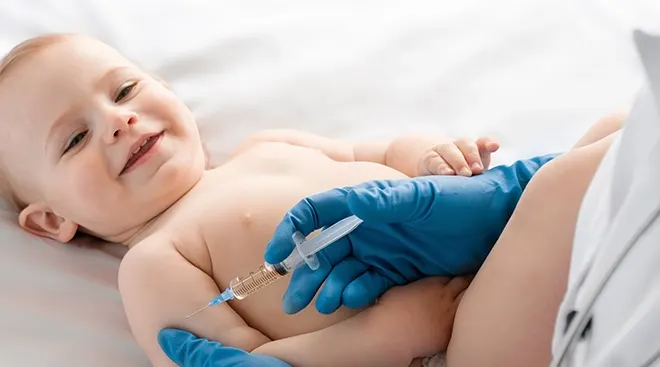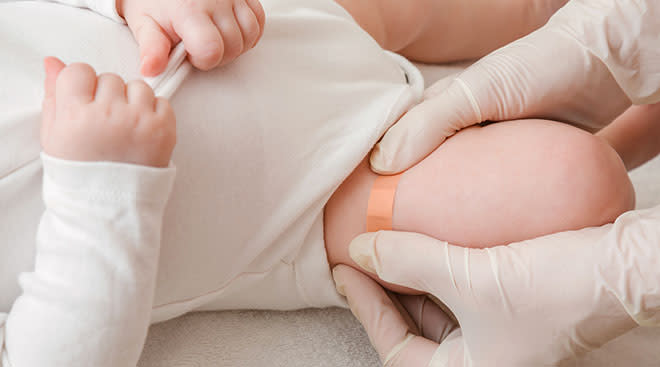What to Expect at Baby’s One Month Checkup
This past month with baby has probably been joyful, exhausting, confusing and completely surreal. And this is why your pediatrician will want you and your little one to come in for a one-month checkup—to ensure everything is on track with their development so far. Baby’s one-month checkup is an opportunity for your pediatrician to assess how your newborn is adjusting to life outside of the womb—as well as how you and the entire family is adjusting to its newest member. But what specifically should you expect from baby’s one month checkup? Here’s what to know and how to best prepare.
“The one-month visit has a strong focus on how baby is growing and developing since coming home from the delivery hospitalization, and how the parents and family are adjusting to their new little one,” explains Elizabeth Cilenti, MD, MPH, a pediatrician with Northern Virginia Family Practice. To ensure baby’s growth is on track, your pediatrician will do a thorough physical assessment of baby, as well as ask you several questions about their behavior, sleeping habits, feeding habits and overall development. Here’s what you can expect:
Physical screenings at the one-month checkup
During each of baby’s checkups, your pediatrician will measure baby’s height, weight and head circumference. All three of these measurements factor into baby’s percentile chart. This chart indicates the average height and weight for boys and girls, and is a tool used by pediatricians to ensure baby’s growth and development are healthy and on track, says Preeti Parikh, MD, a pediatrician in New York City. “Don’t worry too much about the numbers,” she says. “What really matters isn’t baby’s percentile—it’s that baby stays within the same percentile range from checkup to checkup.”
Along with checking baby’s growth, Parikh and Cilenti note the pediatrician will also listen to baby’s heart and lungs and palpate the abdomen. They’ll also check baby’s genitals, eyes, ears, mouth, the shape of baby’s head and fontanelles (the soft spots on baby’s head) to ensure they’re developing properly. Your doctor will also check to see whether baby’s umbilical cord stump has fallen off and how its healing. “During an exam, I’m also assessing baby’s muscle tone, movements, developing head control, eye contact and reflexes like grasping and startling,” Cilenti adds. “ I’ll also put baby on their belly to see if they’re lifting their head. All of this looks like I’m ‘playing’ with the baby, but it gives me a lot of information.”
As for any screenings to expect, “By the one-month visit, your doctor should’ve received the results of your newborn blood-spot screen done at the hospital,” Cilenti says. “This visit is a great time to confirm they’ve received the results and that they’re all normal.”
Developmental assessment at one month
At one month old, baby’s senses, including smell and vision, are still developing. While there may not be too many milestones to look for yet, your pediatrician may walk you through what to expect in the coming months. They’ll also ask some questions about how everyone’s adjusting to their new norms, notes the American Academy of Pediatrics. Some topics that may come up:
- How you’re adjusting to baby’s arrival and needs
- If you’re starting to get used to baby’s cries and able to decipher when and why they happen
- How the entire family is doing and feeling overall with the new baby
- If you feel safe and comfortable
- How your postpartum recovery is going, physically and mentally
- Whether baby has tummy time to counteract flat head syndrome
- How often you have skin-to-skin contact with baby
- How well you’re bonding with baby
Cilenti notes your pediatrician may also ask about your mental health and overall well-being as a new parent, as well as screen you for postpartum mood disorders.
Nutrition check-in at the one-month checkup
During baby’s first month, most of your time is probably spent ensuring baby has enough breast milk or formula to eat. You may also have lots of questions about whether baby’s eating enough, often enough and whether they’re gaining enough weight. “I often find that parents ask a lot of questions about nutrition and feeding at this visit and usually give me most of the information I need in that format,” Cilenti says. But, while your pediatrician will likely learn a lot from your questions, they may have a few of their own. Below, some things your pediatrician may ask:
- Does baby eat breast milk or formula?
- How often does baby feed? How many times in a 24-hour period?
- How much does baby eat at each feeding (if measurable)?
- Does baby drink from a bottle? How’s it going?
- What’s baby’s overall daily feeding routine like?
- Have you been able to spot some of baby’s feeding cues and get acquainted with their eating patterns?
- Are there any issues with feeding at the breast or the bottle?
- How many dirty diapers does baby have per day due to stool and/or urine?
Another aspect of baby’s diet your pediatrician will want to ask about is their vitamin D intake. According to the AAP, vitamin D is an important part of building bone and overall health during the first few years of life. The org notes that infants need vitamin D shortly after birth—and approximately 400 international units daily. At the checkup, your pediatrician may recommend a vitamin D supplement or drops to add to baby’s diet, Parikh says.
Sleep check-in at the one-month checkup
Your one-month-old is probably spending most of their time sleeping, and one of the most important aspects of sleep during baby’s first year of life is safety to prevent sudden infant death syndrome (SIDS). According to the AAP, the safest way for baby to sleep is flat on their back with nothing in the crib except a fitted sheet (so no bumpers, toys or blankets). Some questions your pediatrician may ask about baby’s sleep, according to Parikh and the AAP include:
Child safety check-in at the one-month checkup
Considering how important babyproofing and overall safety is when bringing home baby, it’s likely your pediatrician will ask you some questions on the subject, Clienti says. Along with safe sleep, she notes that your pediatrician may also ask about:
- Car seat safety
- Avoiding falls and burns around baby and with baby in your arms
- Seasonal safety issues (such as water and sun safety during the summer)
- Your return-to-work plan, if applicable, and options for childcare
According to Cilenti and the AAP, baby will get their second dose of the hepatitis B vaccine at either their one- or two-month checkup. “Some practices give it separately at the one-month checkup, others combine it with other vaccines at two months,” Cilenti says.
Wondering what to expect once baby receives the vaccine? Cilenti says the hepatitis B vaccine can cause some soreness at the injection site and potentially a fever. However, if it happens, it’ll usually stay under 101 degrees Fahrenheit. “If a baby under 2 months old has any fever over 100.4 at any time, you should call your pediatrician’s office,” she adds.
It’s likely you have many questions for your pediatrician as you learn the ropes of life with baby. According to Parikh, one of the best ways to prepare for baby’s one-month checkup is to write down any and all questions as they come to you. This way, you’ll remember to ask all of them. Below, experts share some questions that may be helpful to ask:
- Are my baby’s growth and weight gain on track?
- How can I tell if baby is developing normally?
- What are some developmental milestones I should be looking out for?
- What are some signs my one-month-old baby is having trouble feeding? Sleeping?
- How regularly should baby be pooping and peeing?
- What should I do if baby gets constipated or gassy?
- Is it safe to give baby gripe water or gas drops?
- What should I do if baby’s cries become too much for me to handle?
- How do I handle colic?
- How can I make sure baby’s crib and sleep environment is safe?
- Where can I learn infant CPR?
- How can I treat baby’s cradle cap?
- What do I do if baby spits up?
- Why does baby have acne, and how can I take care of their skin?
- When is it safe to take baby outside?
- What are your recommendations for finding a support system for new parents?
- Is there anything else I should know or be doing?
- If my baby feels warm, what’s the best way to take their temperature, what is considered a fever and what should I do if my baby has a fever?
Cilenti says parents should bring an extra change of clothes and diapers and wipes just in case there’s a long wait at the doctor’s office and baby has a blowout.
Caring for a newborn can be overwhelming. Remember that even after baby’s one-month checkup, your pediatrician is there to help. Don’t hesitate to flag any questions or concerns that come up before baby’s next wellness visit, which will be at 2 months old.
Please note: The Bump and the materials and information it contains are not intended to, and do not constitute, medical or other health advice or diagnosis and should not be used as such. You should always consult with a qualified physician or health professional about your specific circumstances.
Elizabeth Cilenti, MD, MPH, is a pediatrician with Northern Virginia Family Practice. She completed her medical degree and residency at Indiana University School of Medicine and her master’s degree in public health at the Harvard T.H. Chan School of Public Health.
Preeti Parikh, MD, is a pediatrician with Westside Pediatrics, located in New York City, as well as a spokesperson for the American Academy of Pediatrics. She earned her medical degree from Rutgers University and completed her pediatric residency at Mount Sinai Hospital.
Healthy Children (American Academy of Pediatrics), Checkup Checklist: 1 Month Old), September 2021
Healthy Children (American Academy of Pediatrics), Vitamin D for Babies, Children & Adolescents, August 2022
Centers for Disease Control and Prevention, Definitions, April 2022
Learn how we ensure the accuracy of our content through our editorial and medical review process.
Navigate forward to interact with the calendar and select a date. Press the question mark key to get the keyboard shortcuts for changing dates.




















































